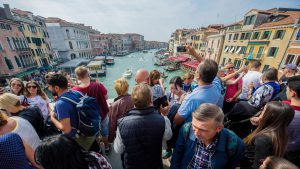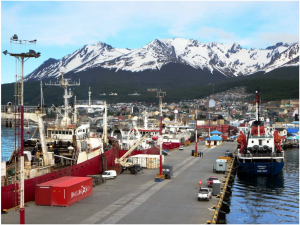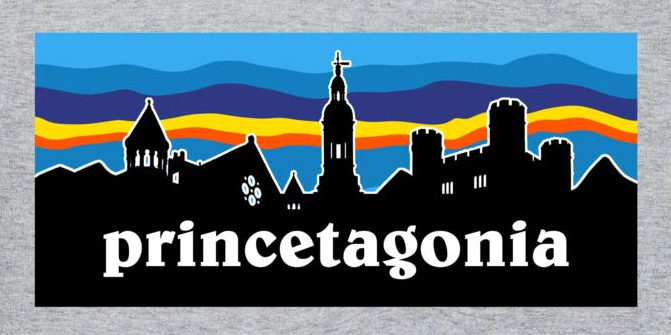Introduction
Tourism has been on the rise in recent years, and more people are traveling to national parks and other nature-rich destinations

as the tone around climate change becomes more and more alarming over irreversible human industrialization. Tourism now makes up about 10% of the world economy, and new tourist hotspots like Iceland praise the tourism industry as their “savior” (Kummerer) while tourist-destination veterans, Such as Venice and Spain, attempt to curb tourism to give back jobs to their local and seasonal workers (Crabtree).
Patagonia represents the intersection of the boom in nature conservation awareness and popular destinations, providing us with a unique perspective into the effects of modern tourism on local regions, including the environmental impact of tourism.

Perceptions of Patagonia
Patagonia is a region shrouded in mystery. Few people know the exact location. In the 21st century, most people probably know the company Patagonia better than the actual place. Founder of Patagonia, Yvon Chouinard, picked the name for this very reason:
“To most people, especially then, Patagonia was a name like Timbuktu or Shangri-la—far off, interesting, not quite on the map. Patagonia brings to mind, as we once wrote in a catalog introduction, “romantic visions of glaciers tumbling into fjords, jagged windswept peaks, gauchos and condors.” Our intent was to make clothing for those rugged southern Andes/Cape Horn conditions. It’s been a good name for us, and it can be pronounced in every language.”
—Yvon Chouinard, Let My People Go Surfing, pg. 38
These emotions evoked by the name Patagonia can be traced back to “the result of the intervention of a sole individual, the British naturalist Charles Darwin … Darwin established a compelling repertoire of images and tropes that has ruled the system of representations of Patagonia until today” (Nouzeilles, 5). In his Voyage of the Beagle, Darwin describes Patagonia as a desolate land where “the hour of life has run its course” (Darwin, 166). This perception made a lasting impact with the rest of the world, and until Bruce Chatwin came along in the 1970s, Patagonia for the outside world remained Darwin’s Patagonia.

Increasing Tourism in Patagonia
Over the years, Patagonia has changed from this “savage land” imagery with the introduction of sheep farming, but there are still very few people living in the region, and, until In Patagonia by Bruce Chatwin pushed Patagonia into the eyes of tourists, the region was not well-known in other areas of the world. As Chatwin’s journal brought Patagonia into the tourism industry and Chouinard’s company brought the name Patagonia to regular people outside of Chile and Argentina, accessibility increased and more people began to travel to Patagonia for leisure. What started as a location for hardcore outdoor enthusiasts—mountain climbers, rock climbers, and more—has turned into a hot spot for tourism, especially among the environmentally conscious. In recent years, the expansion of Patagonian tourism has also impacted Antarctic tourism, where we see rising numbers almost every season.
A look into a guided tour of Patagonia—pretty outdoorsy, but all very planned out and organized
As tourism increases, local industries have consolidated their goals to two main objectives: preserve the parks, and increase the number of tourists. Park planners and others involved in the tourism industry put measures in place to accomplish these goals to create a form of sustainable tourism, where the tourism industry can keep growing with limited impact on the environment, the main tourist attraction. They try to control the flow of tourists through parks to create the smallest environmental impact possible and aim to grow the tourism industry while still preserving the reason why tourists come in the first place: the nature and wildlife. Despite rigorous attempts at park planning, however, not all tourists follow the rules, leading to unwanted human impact in highly sensitive areas.
Measuring Human Impact

Preserving the parks is necessary to keep tourists coming to the region, and the tourists are integral to increasing the money that enters their local economy. To increase tourism, people employ different forms of land and human impact analysis to discuss possible conservation measures and the best way to grow their industries while having minimal impacts on the environment. Different systems of analysis consider measure different factors, such as greenhouse gas emissions, an arbitrary human disturbance index, human infrastructure, and more. These different systems for analyzing human impact on the environment are utilized by sectors of the tourism industry in Patagonia because “many local and regional planners warn that nature-based tourism development is not automatically sustainable” (Gale, 22).
Impact on the Environment
Congestion in photogenic areas “has led tourists to find new lookouts in contiguous sites and consequently create new paths to reach them”(Ruiz, 753). These small actions, when repeated many times by thousands of tourists every season, have a lasting impact on the environment. Previous research on Chilean Patagonia has claimed that approximately 73.9% of the land is undisturbed by human activity (Inostroza, 2080), but in depth research reveals that “more than 68.1% of the total regional surface is affected to some degree by direct human transformation or subjected to pressure by various economic activities”(Inostroza, 2083).

This means that only 38.2% of the land is truly undisturbed, which is almost half of the original amount of the supposedly undisturbed land in Patagonia. Humans have a tremendous impact in the direct environment as well as the surrounding ones as well, and these impacts are felt much more strongly in a place like Patagonia, “a highly sensitive environment with low ecosystem homeostasis”(Inostroza, 2083) because the environment cannot quickly and effectively counter the human disturbance. As the human impact analyses reveal, park planning seems largely ineffective in turning the tides of the impact of mass tourism.
Conclusion
Despite awareness for the need of sustainable tourism from both the hosts of the tourism locations and the tourists, by the very nature of the tourism industry, it is impossible to create a truly sustainable form of tourism.

Many of the policies that evaluate human disturbance in the region are aimed at making park planners aware of the human impact that could occur on an environment so they create plans with minimal impacts on the ecosystems. Despite hopes for conservation from the park planners, the fact that they are wanting to increase tourism for the sake of their business or for the local economy contradicts the notion of environmental conservation. An increase in tourists (that are mostly international) creates a massive increase in emissions such as carbon into the environment. Of course, the carbon footprint of tourists is not the responsibility of the tourism industry—it is the responsibility of the tourists to be aware of the carbon footprints that go into travel—but the tourism industry is willing to make this tradeoff for the sake of increasing tourism for profit.

Tourism and conservation are inherently at odds with each other. The objective of tourism is to make a profit from the travelers who have excess money to bring the money into the local economy, but in order to do so, the environment is harmed even further because for tourism to occur, travel is necessary, and traveling on planes or boats or trains leave massive footprints, not to mention the fact that people cannot be controlled in parks to follow strict sets of rules. Sustainable tourism itself is a paradox: no true form of tourism is sustainable because the act of tourism increases the human impact in a place with minimal impact otherwise.
Further Readings
Aamir, Alamzeb, Elsherbini Elashkar, Elsayed, Imran Qureshi, Muhammad, Mohamd Shoukry, Alaa, Nik Mahmood, Nik Hasnaa, Rasli, Amran Md., and Zaman, Khalid. “Measuring the ecological footprint of inbound and outbound tourists: evidence from a panel of 35 countries,” Clean Technologies and Environmental Policy, no. 21 (2019): 1949-1967.
Adiego, André, Adnie, Andrea, and Gale, Trace. “A 360° Approach to the Conceptualization of Protected Area Visitor Use Planning Within the Aysén Region of Chilean Patagonia.” Journal of Park and Recreation Administration, no. 36 (2018): 22-46.
Barrena Ruiz, José, Blanco Wells, Gustavo, Bush, Simon, and Lamers, Machiel. “Governing nature-based tourism mobility in National Park Torres del Paine, Chilean Southern Patagonia,” Mobilities 14, no. 6 (2019): 745-761.
Chouinard, Yvon. Let My People Go Surfing. New York: The Penguin Press, 2005.
Crabtree, Justina. “Anti-visitor sentiment sweeps some of Europe’s most popular destinations.” CNBC, September 5, 2017, https://www.cnbc.com/2017/09/05/tourists-not-welcome-popular-european-destinations.html
Darwin, Charles. “Voyage of the Beagle.” Edited by Janet Browne and Michael Neve.
Inostroza, Luis, König, Hannes J., and Zasada, Ingo. “Last of the wild revisited: assessing spatial patterns of human impact on landscapes in Southern Patagonia, Chile.” Reg. Environ Change (2016): 2071-2085.
Kummerer, Samantha. “Eco-friendly tourism is becoming a movement, and more vacationers are buying into the concept.” CNBC, April 28, 2017. https://www.cnbc.com/2018/04/27/ecofriendly-tourism-is-becoming-a-movement-and-more-vacationers-are-buying-into-the-concept.html.
Nouzeilles, Gabriela. “The Iconography of Desolation: Patagonia and the Ruins of Nature.” Review: Literature and the Arts of the Americas 40, no. 2 (2007): 252-262.


